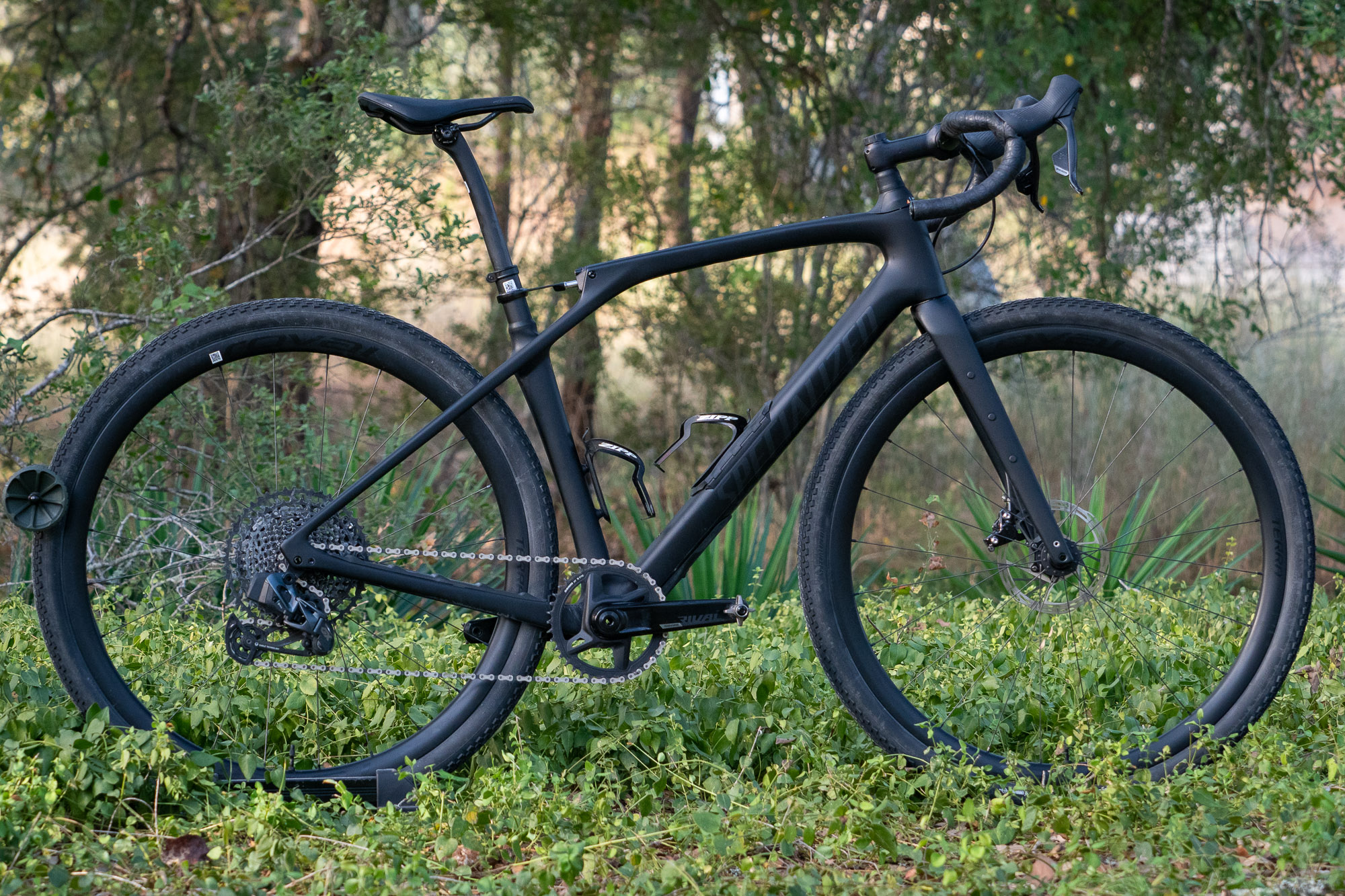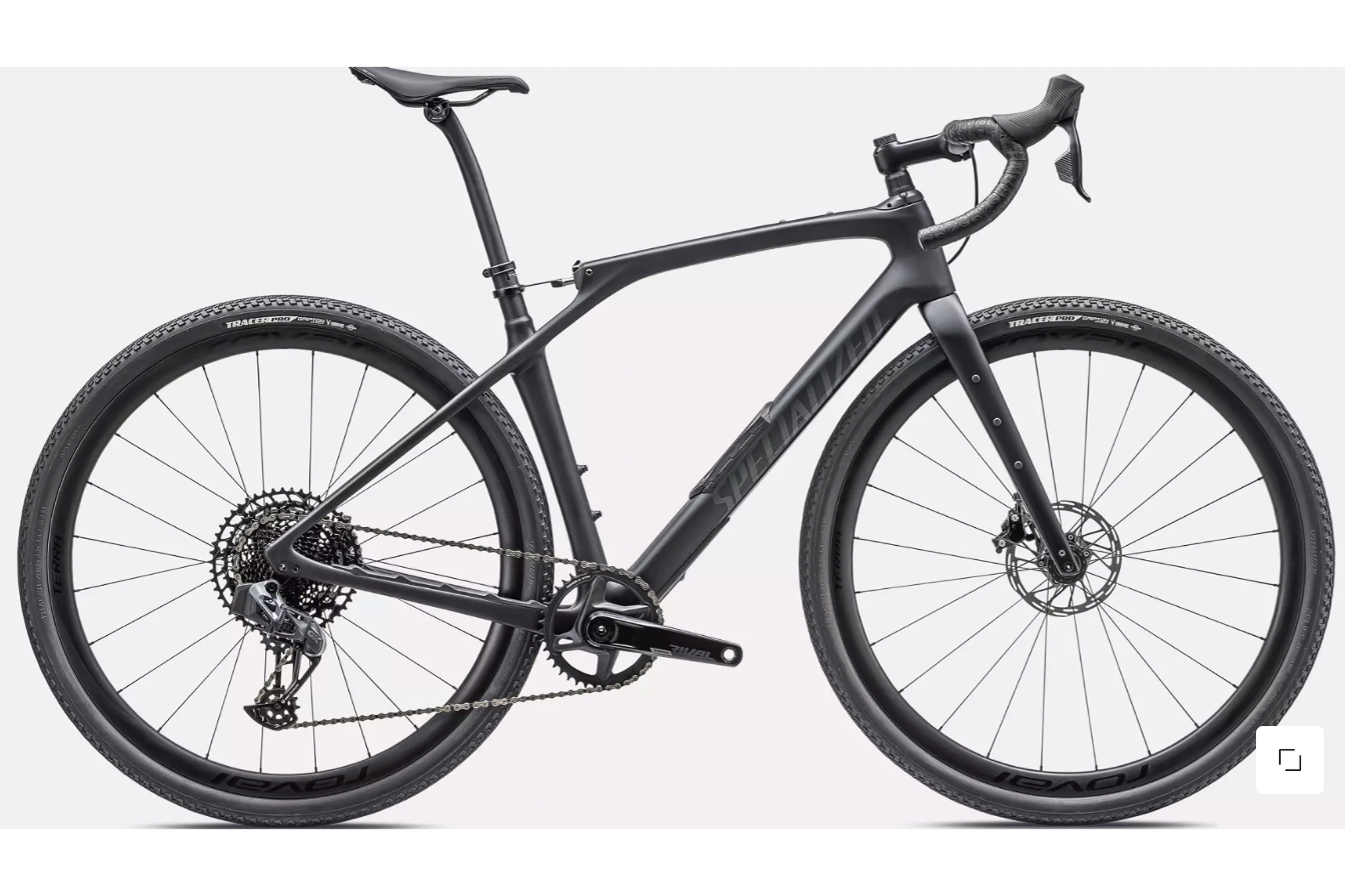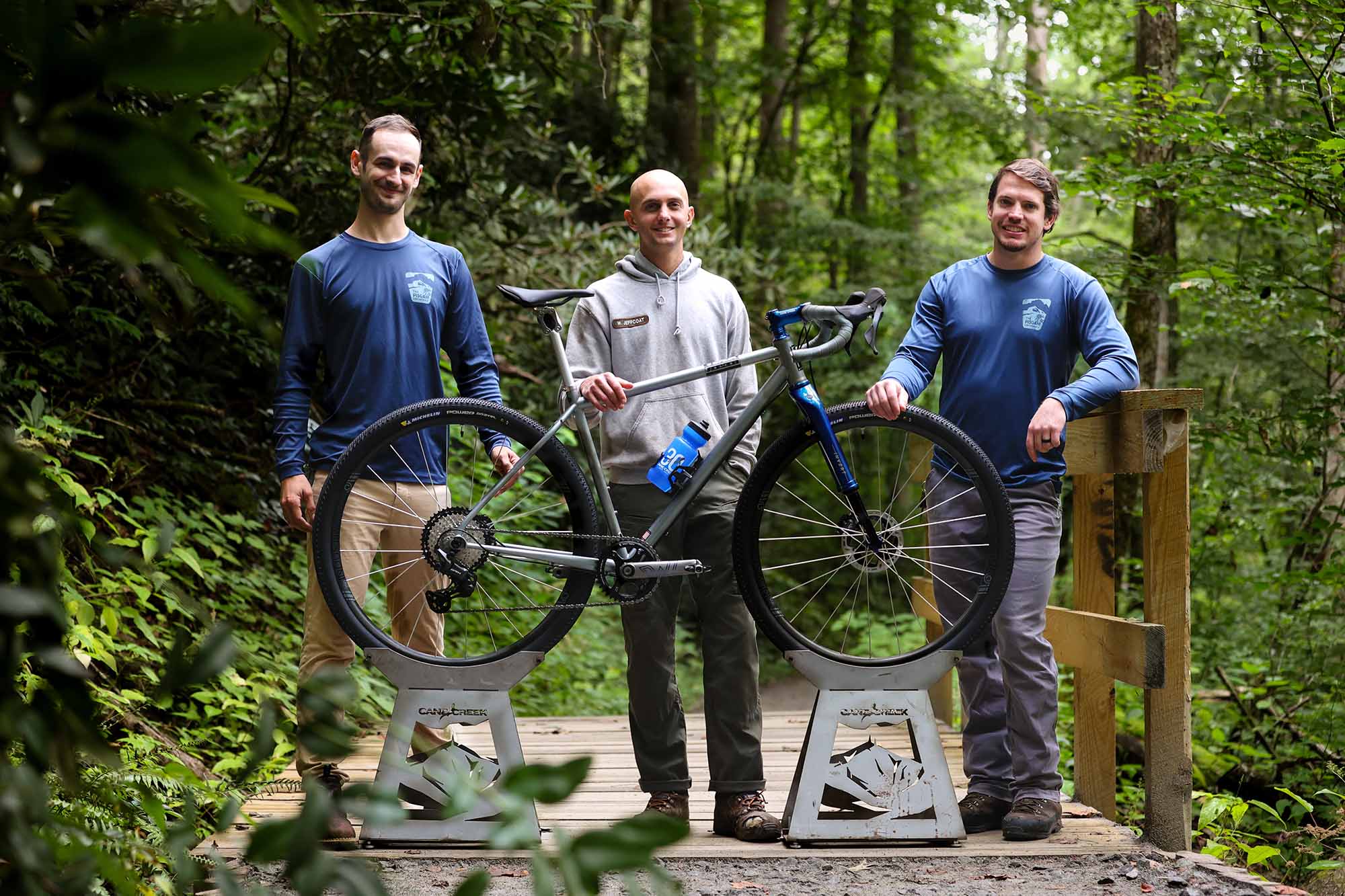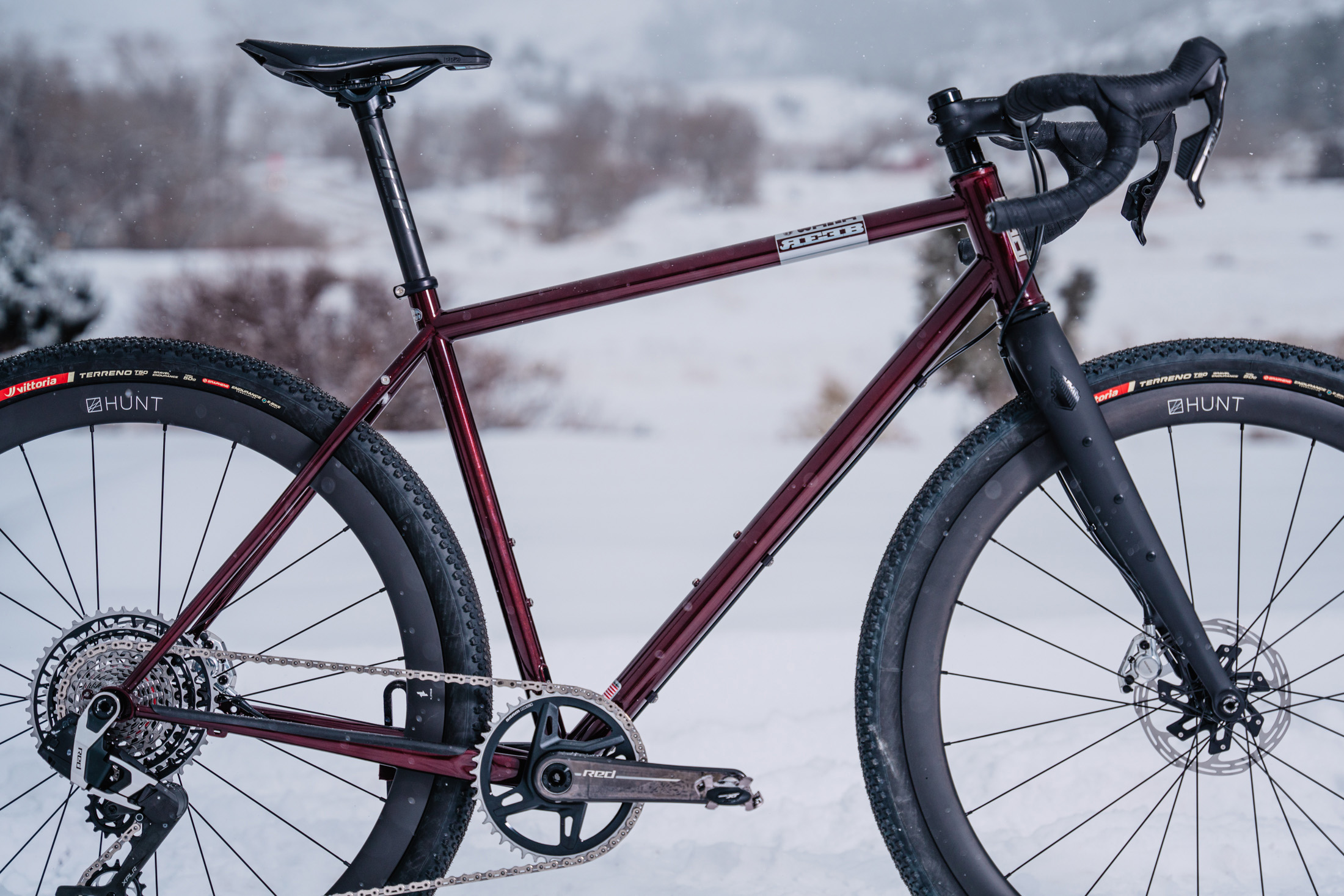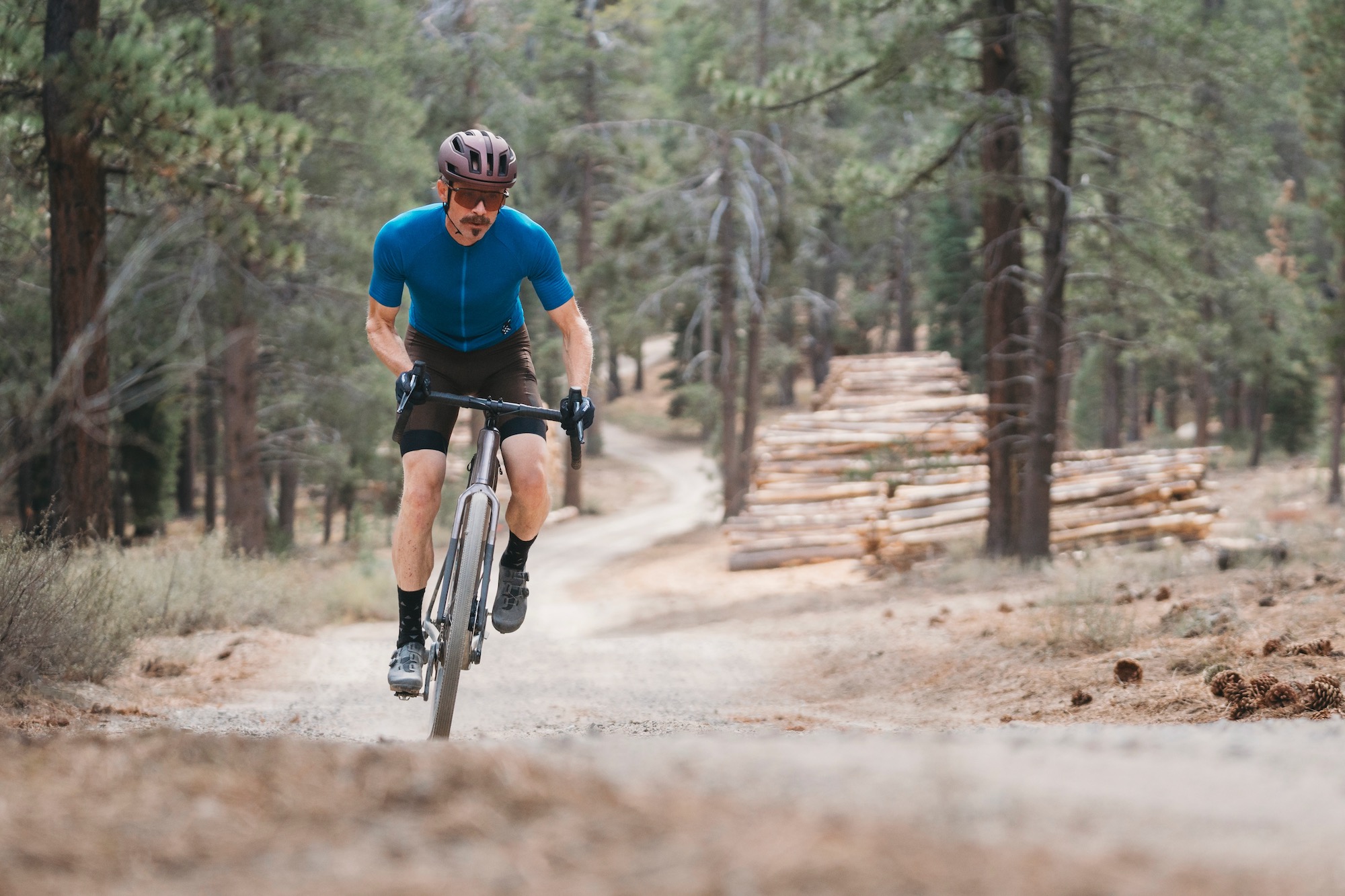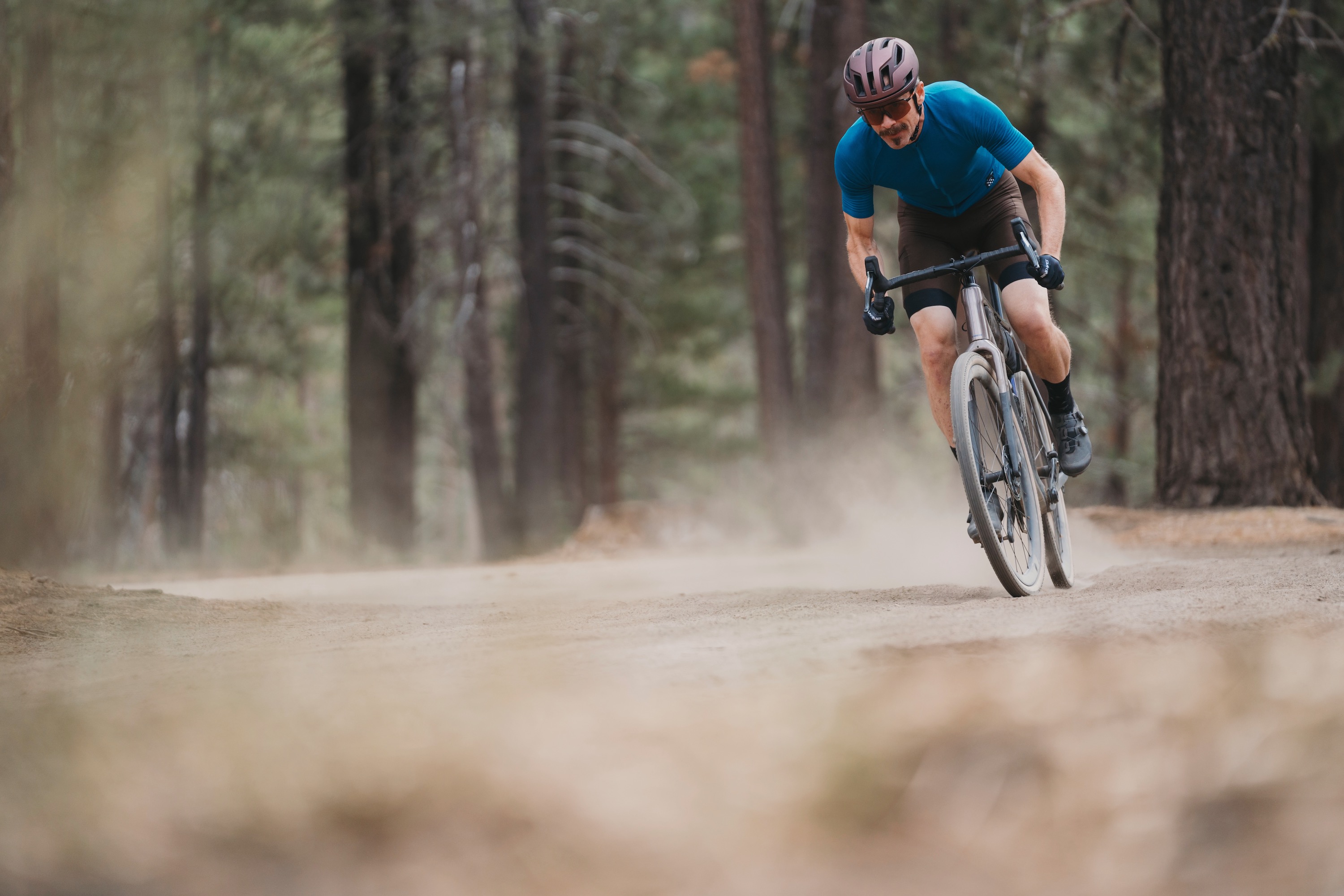The Specialized Diverge STR gravel bikes use a seat tube insert as a spring for the rear suspension, and the entire front cockpit moves vertically to damp front wheel travel. This is unlike any other full-suspension system on any bicycle.
When I unboxed the Specialized Diverge STR Expert for this review, all I could think was, “This is so weird.” I’m very accustomed to seeing and feeling out suspension, both on bicycles and motorcycles.
But the Suspend The Rider (STR) suspension system throws out convention. And as much as I applaud breaking from the status quo, I wasn’t convinced the strange suspension method would deliver a ride that felt anything near “normal.”
First, neither of the wheels is suspended, which immediately seemed strange. The rear suspension involves a seat tube insert acting as a spring and a pull shock in the top tube, damping forward and rearward seat post travel. Yep, weird.
The front suspension involves the stem and handlebars moving vertically, damped by a cartridge inside the head tube. Again, it seemed so strange. I couldn’t imagine the bike feeling anything like any other fully suspended bike or motorcycle I’d ever ridden.
I tested the Specialized Diverge STR Expert for 6 months, riding around my home in the woods of Wimberley, Texas. Most of the terrain was hardpack caliche base with a topcoat of talcum dust and littered with limestone rocks ranging from pebbles to softball size. Plenty of square edges hide in the dust, as well as deep sand along drainages. Finally, numerous dry creekbed crossings at the bottom of hills require caution.
In short: The front and rear Future Shock on the Specialized Diverge STR Expert improved control and comfort dramatically when gravel riding bordered on mountain biking. There is no denying that the suspension system works well. But there is also no avoiding the strange initial feeling of the suspension movement. The Future Shock system is an acquired taste that pays huge dividends if “super chunk” gets you excited.
- Frame material: Diverge FACT 11r carbon
- Weight: 21.8 lbs., 56cm
- Tire clearance: 700 x 45c
- Available sizes: 49, 52, 54, 56, 58, 61cm
Pros
- Suspend The Rider suspension system improves comfort and control without affecting pedaling efficiency or handling
- Component selection provides great bang for the buck
- Bike is flexible; it can be raced and go bikepacking
- SWAT internal storage is significant in volume
Cons
- Heavier than comparable gravel bikes
- More expensive than comparable gravel bikes
Specialized Diverge STR Specifications
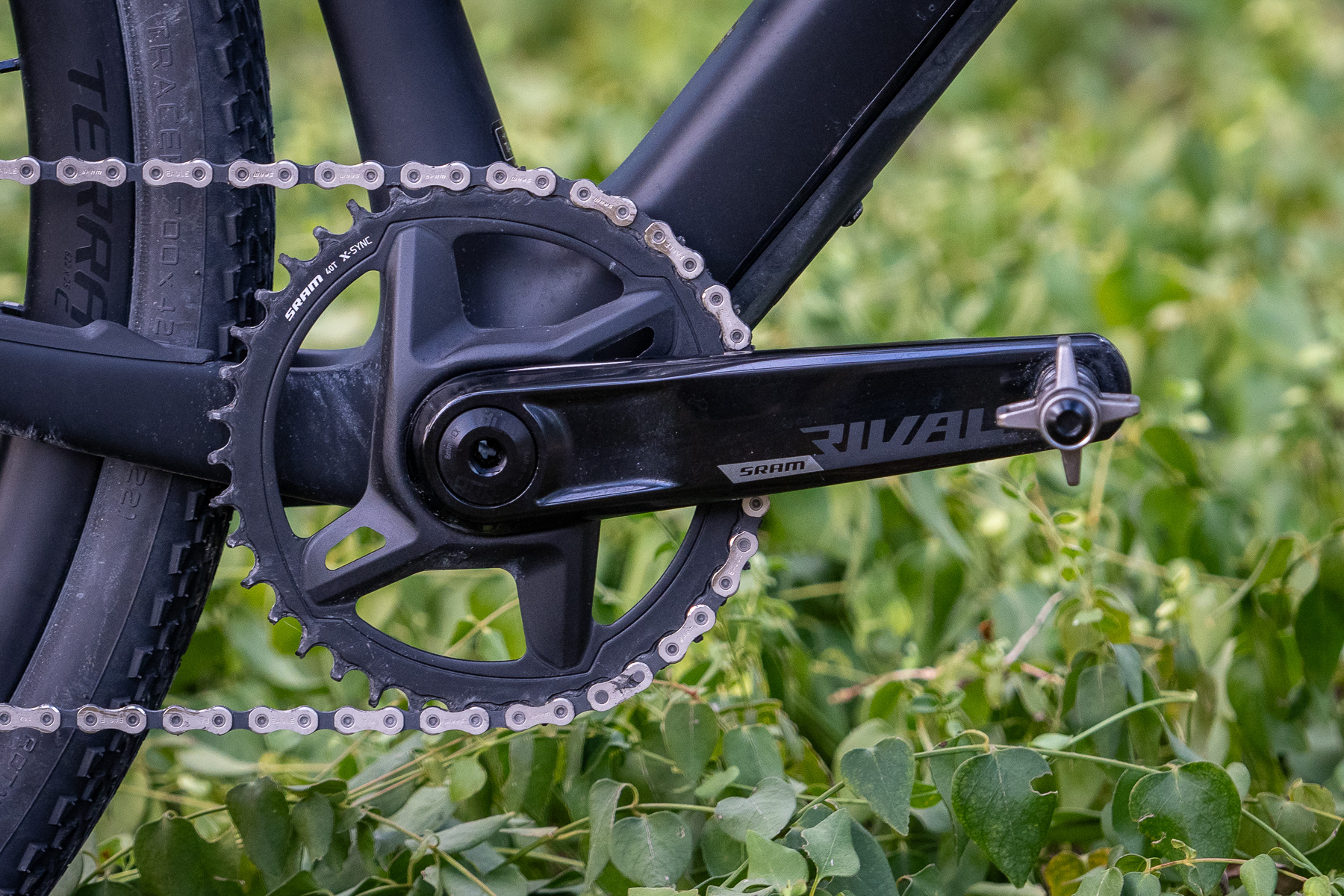
The Diverge STR blends SRAM lower-tier components and second-tier frame material to produce a bike that costs almost half as much (MSRP $6,700, on sale at the time of writing for $5,000) as the top-of-the-line S-Works Diverge STR (MSRP $12,500).
Specialized molds its Diverge STR Expert frame with proprietary Diverge FACT 11r carbon. It has internal storage in the downtube and a threaded bottom bracket. The front and rear Future Shock suspension components live within the frame, and all cable routing is semi-internal. The Diverge STR frame is only compatible with 1x drivetrains.
There are three water bottle cage mounts, front fork rack mounts, front fender mounts, and a top tube bag mount. The frame will clear 45c tires.
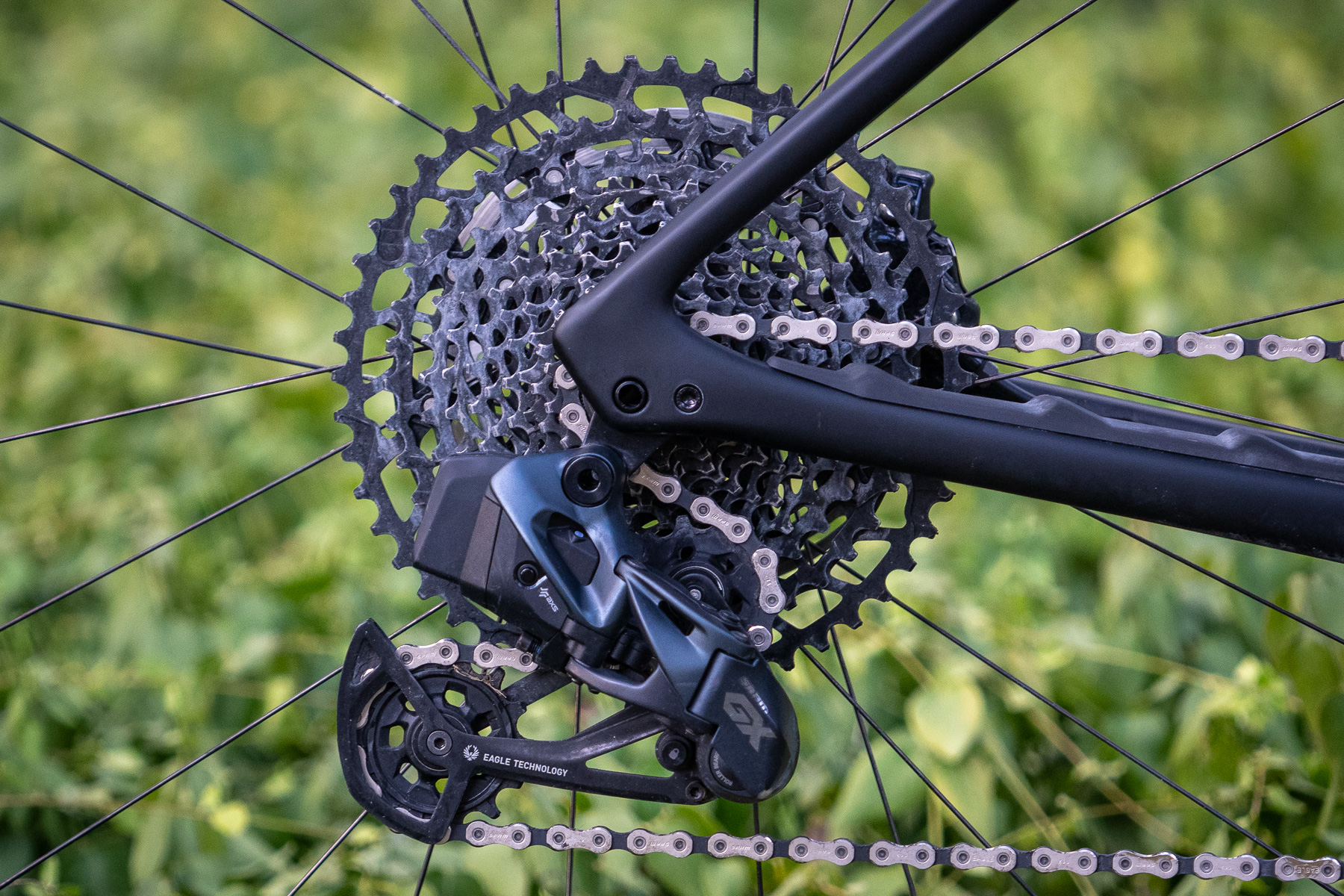
The drivetrain is a “mullet” configuration using SRAM wireless road and mountain bike components. The 1x Rival 40t Wide crankset and SRAM DUB BSA bottom bracket join a GX Eagle AXS rear derailleur. A 12-speed NX Eagle 11-50t cassette and Rival eTap AXS brake-shift levers complete the drivetrain.
Roval Terra C carbon wheels spin on DT 370 hubs and DT Swiss Comp race spokes. Specialized Tracer Pro tubeless tires in 42c provide grip. SRAM Rival eTAP AXS hydraulic units handle braking duties.
Specialized rounds out the Diverge STR Expert build with its cockpit components. Interestingly, Specialized includes an S-Works carbon seat post instead of the more flexible Roval Terra post.
My 56cm test sample weighed a verified 21.8 pounds without bottle cages or pedals.
Specialized Diverge STR Suspension Explained
Specialized aptly named this bike; STR stands for “suspend the rider,” and that is exactly what the design does, instead of spending the wheels.
Instead of damping vertical wheel travel, the bike damps vertical rider travel. This is a distinct line in the sand, and comparing “standard” suspension to STR suspension is futile. They feel completely different, and each has advantages and disadvantages.
I will state right away that the glaring disadvantage I felt on the Diverge STR was simply that it was an unfamiliar feeling, and it took me quite some time to adapt. When the bike suspends the wheels, I quickly learn to predict how the bike will “bounce.”
With the Specialized Diverge STR, the bike didn’t “bounce.” I did. The reaction of the bike to the terrain was hard for me to predict and initially seemed like a mismatch to what I felt. I didn’t feel comfortable bombing things at full speed for a month.
But STR has advantages, and many of them were not obvious until I had grown accustomed to the system. One advantage is that rear suspension travel doesn’t at all affect pedaling efficiency. The rear triangle is solid, just like on an unsuspended gravel bike.
So, there is no loss of energy due to suspension movement eating up chain tension. Specialized first developed Future Shock for use in WorldTour road racing, where drivetrain efficiency is crucial.
Another advantage is since the wheels are held rigidly in the frame, chassis geometry doesn’t change due to suspension travel. With “standard” suspension, compressing or extending forks and shocks changes head angles, seat tube angles, and everything else that revolves around these parameters.
Additionally, the fork is solid, so there isn’t nearly the potential for front axle twisting and other movement that can negatively affect handling.
Lastly, compared to standard forks and shocks, the STR system’s maintenance requirements are much lower. It helps that both damping units are housed within the frame, protected from dirt, dust, and the elements.
Future Shock Nuts and Bolts
The front Future Shock provides 20mm of hydraulically damped vertical travel of the stem and handlebar. A knob on top adjusts compression damping, and it has a full lock setting.
The rear Future Shock delivers 30mm of travel in a downward arc, opposite of the arc the rear axle would travel on a “standard” rear suspension setup. It has an external lever that sets it in a fully locked, medium, and soft compression setting. A screw underneath the top tube adjusts the rebound.
It’s not too hard to visualize how the spring and oil-damped front Future Shock absorbs hits, given its simpler vertical travel path and obvious damper placement. What is harder to see is how the rear Future Shock allows the seat to move down and back.
The frame’s seat tube has a “framepost” inside, which anchors just above the bottom bracket. This frame post is mostly fiberglass and carbon and essentially becomes an extension of the actual seat post.
It can flex freely inside the frame’s seat post, and the hydraulic Future Shock inside the top tube controls this movement. A metal “tendon” attaches the frame post to the damper.
Specialized includes two different frame posts with each bike, each of which can turn 90 degrees to deliver a different spring rate. So, each bike has four different rear Future Shock spring rates, and there are nine different frameposts available. Although swapping frame posts is a significant undertaking, I applaud Specialized for accommodating rider weights between 100 and 270 pounds.
The Specialized Diverge STR Expert on Gravel
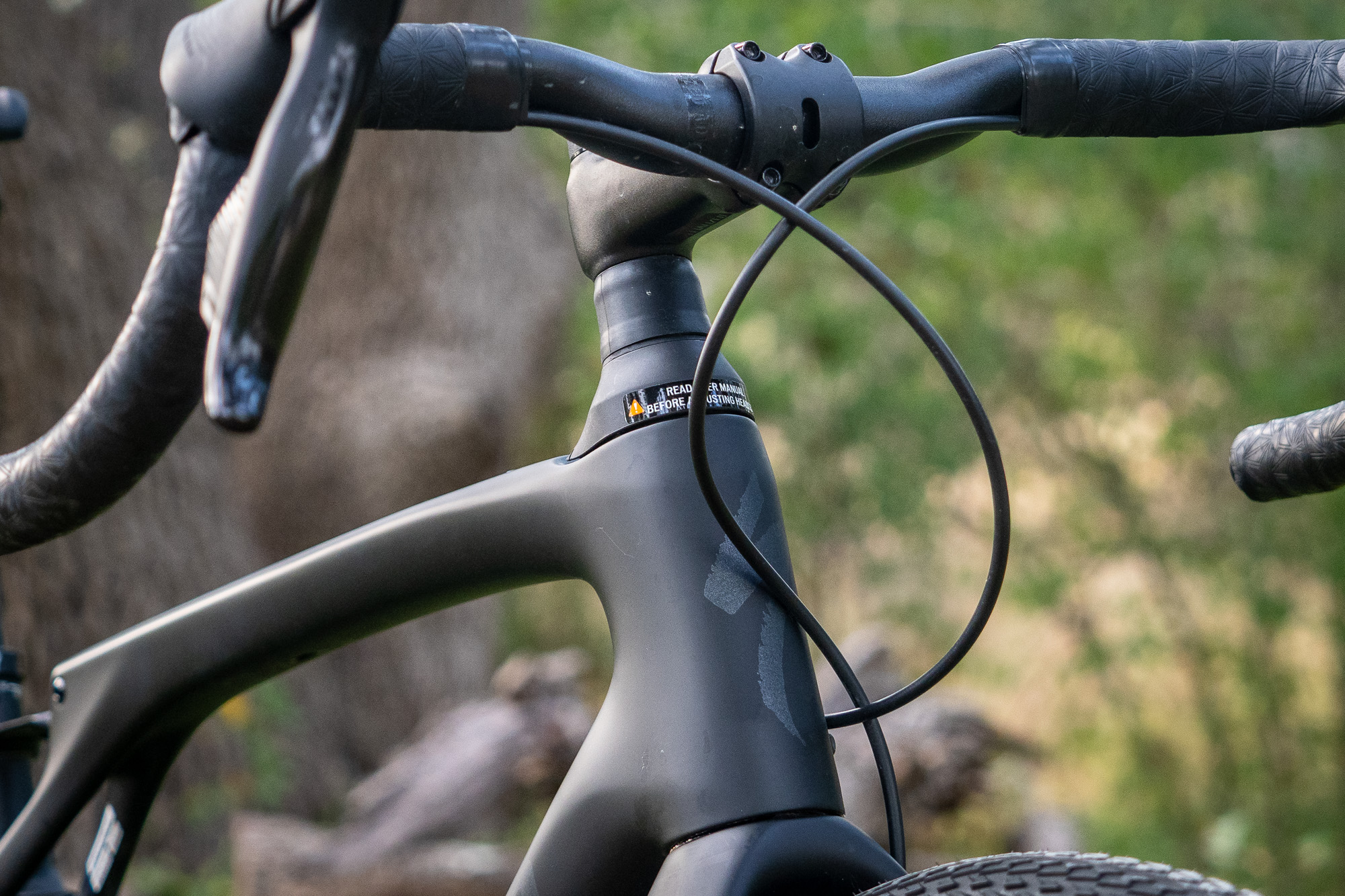
All the “Suspend The Rider” (STR) talk and marketing looked impressive. But I was squarely in the comfort zone of “standard” suspension from decades of riding mountain bikes and motorcycles. It was going to take a lot for me to trust how the bike would react to the bike suspending my body instead of the wheels.
Initial Impressions of Future Shock
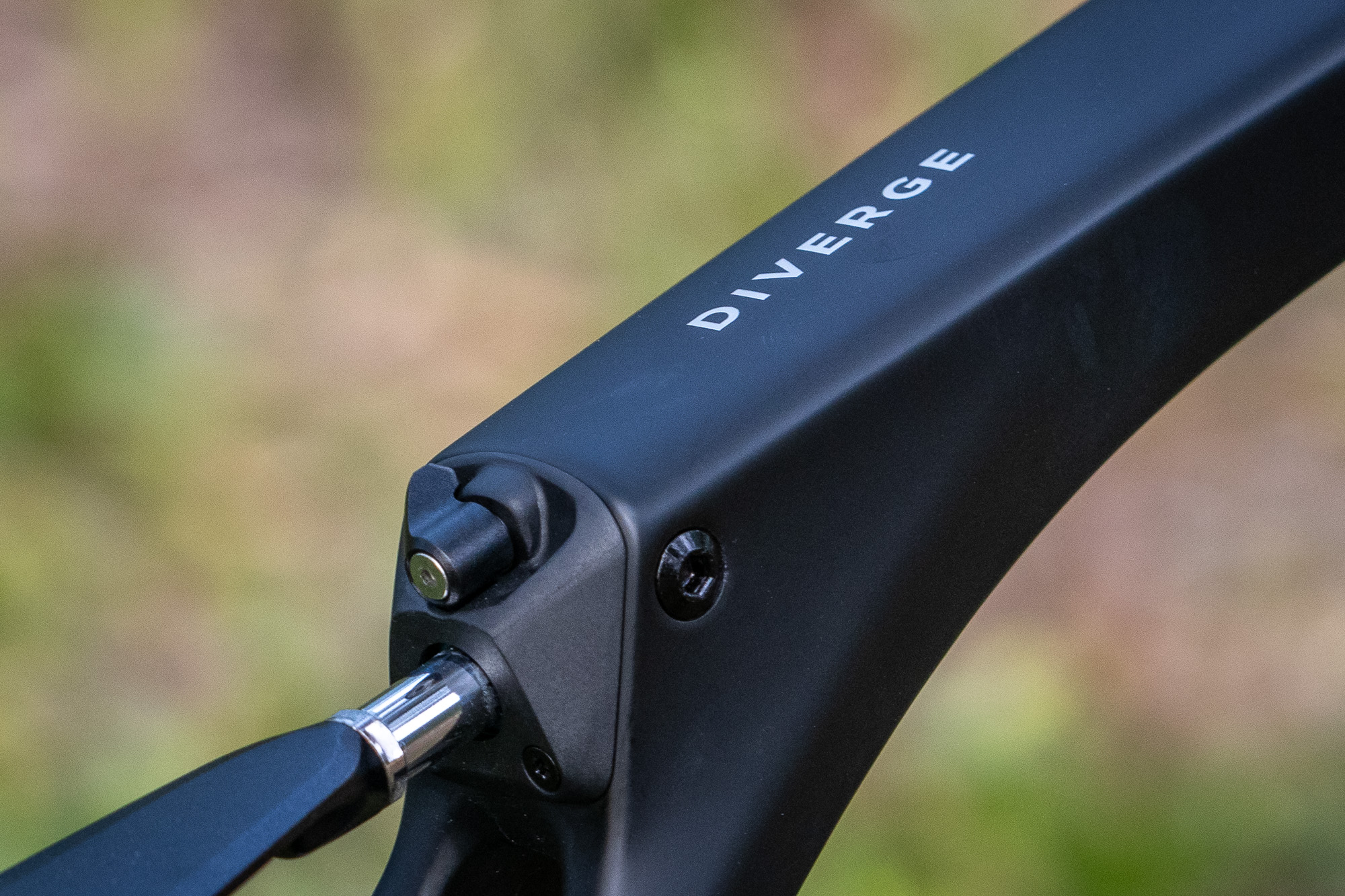
My first few rides aboard the Diverge STR left me with mixed feelings. The front Future Shock wasn’t too hard to get used to since I had tried suspension stems. I preferred the Future Shock’s linear travel path of the bars instead of the arc that the elastomer-damped stems provide, as it left the angle of the brake hoods and my wrists consistent.
It had much more travel, too, but it only took me a few rides to adapt. I felt it worked the best when I left the damping wide open most of the time.
The rear Future Shock gave me fits at first. As soon as I got on and weighted the saddle, it sagged under my body weight enough that I stopped and slid the saddle forward a bit to maintain the fore-aft position that felt biomechanically correct.
Then, while climbing seated, the saddle moved more than I could tolerate in the wide-open setting. I did open up the rebound a bit, but I didn’t mess with changing frameposts, as I had limited time with the bike. I ended up leaving it in the middle setting most of the time.
The rear Future Shock bobbed when grinding up climbs while seated, and the higher the gear and the more torque I produced, the more pronounced this became. Once I got used to the sensation, I didn’t feel like it negatively affected my performance. It, along with the front Future Shock, definitely helped me maintain my pedaling rhythm, cadence, and forward momentum when the terrain was rocky and ledgy.
I also had to remind myself that the rear suspension system didn’t benefit me if I was standing on the pedals. It took some retraining to stay seated when descending washboard sections. But when I finally broke the standing habit aboard the Diverge STR, the bike rewarded me with the ability to pedal while seated with incredible comfort.
The front and rear STR systems really shined when I pedaled high gears under high torque to get across long sections of rough terrain at speed. I could stay aero, slide back on the saddle, and really power through with much better rhythm and consistent power than on an unsuspended bike.
And square edges that normally irritated my reconstructed left wrist didn’t bother me at all. This was a huge benefit of the STR system for me in particular.
Finally, on long days in the saddle, regardless of the size of the bumps, the Specialized Diverge STR absolutely delayed fatigue in both my arms and backside. It was really noticeable when I rode longer days back to back with a rigid gravel bike. The difference in comfort after some fatigue set in was astounding.
Frame Geometry
Although the Specialized Diverge STR’s geometry initially didn’t appeal to me, it eventually felt appropriate for what I considered the bike’s most likely use cases.
The stack on the Diverge STR immediately felt high to me at 609mm for the 56cm tester. For comparison, my “daily driver” gravel bike is a Ventum GS1, which, for the comparable size, has a stack of 570mm, a considerable difference.
The stem on the Diverge STR can be lowered, but it’s a much more involved process than with a rigid front end and requires proprietary parts. But it still wouldn’t have gotten close to the height of the nearly slammed stem on the GS1.
The Diverge STR’s wheelbase is also significantly longer, and the bottom bracket is much lower. These combined to give the bike a more stable feeling at speed in rough sections, but they also made the steering feel sluggish at times.
However, the taller stack and more stable chassis, along with the suspension, made the bike more suitable for rougher, more adventurous terrain than what I usually ride. In those conditions, the Specialized Diverge STR’s suspension, cockpit, and chassis characteristics made it superior.
Component Performance
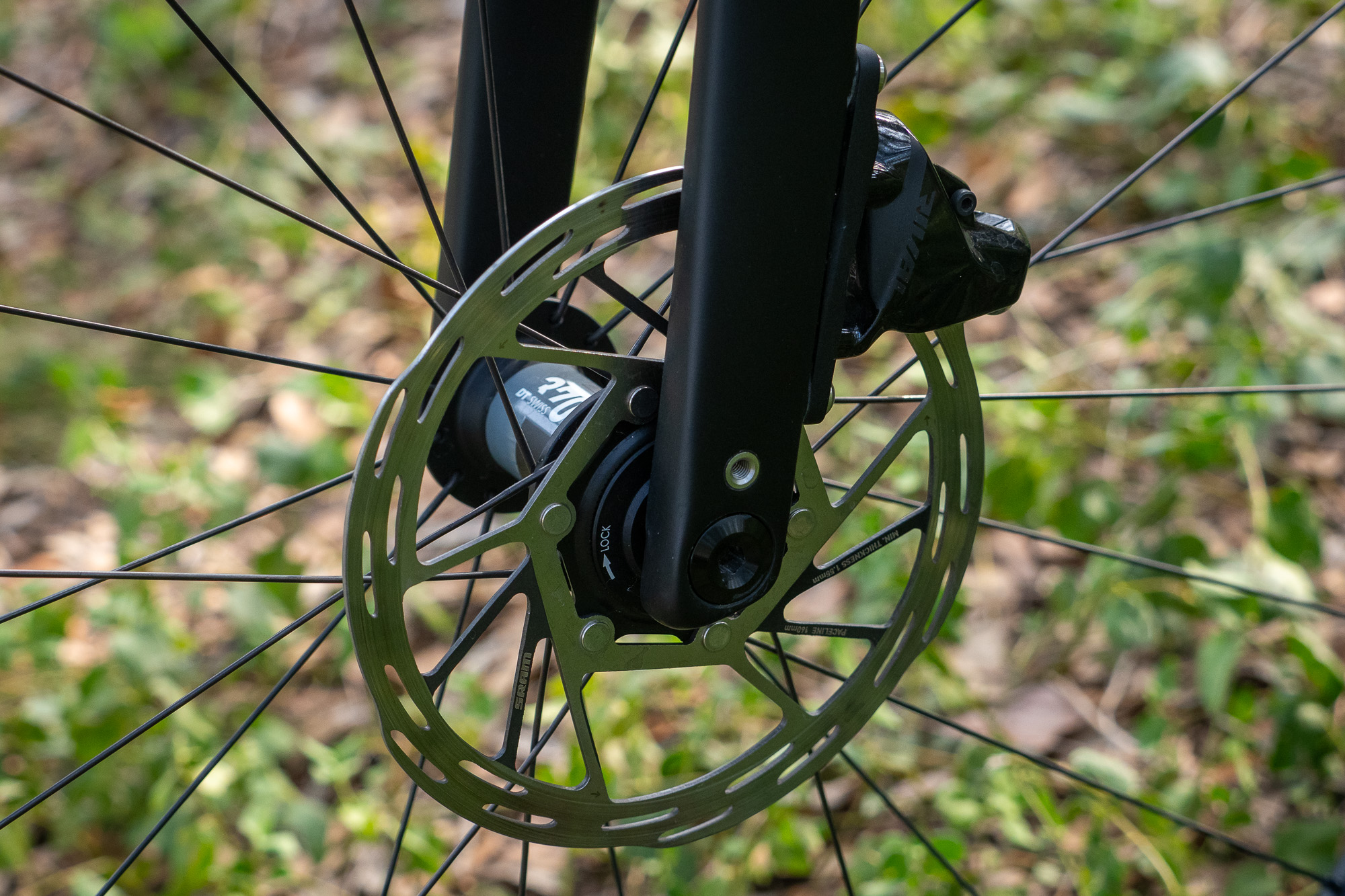
Specialized offers four tiers of Diverge STR models. The S-Works stands atop, while the tested Diverge STR Expert is the second one up the chain. To achieve a price that is almost half of the S-Works version, Specialized outfits the Expert model with lower-tier components.
The SRAM Rival eTap AXS drivetrain with Eagle GX AXS derailleur and Eagle cassette didn’t disappoint, though. It shifted reliably and smoothly, and the mountain bike cassette with lower gearing provided a bail-out gear I wished I had on my RED-equipped bike.
The difference in overall shifting performance between the Rival and RED drivetrains was marginal, so I felt like this was a great way to lower the price of the Diverge STR.
The braking was fine as well. Once the discs were bedded in, the initial bite, progressiveness, and power were all predictable and appropriate for gravel. Compared to RED, the initial bite wasn’t as “crisp,” and the progressiveness wasn’t as steep. The total power was also down, but the Rival brakes delivered more than enough.
The RED levers, however, required much less force from my fingers, and I could brake as hard as I wanted with a single finger while on the hoods. This one-finger braking wasn’t possible for me on the Rival setup.
The Roval Terra C wheels handled everything well and were laser-straight at the end of the testing period. The 42c Specialized Tracer Pro tires have always been among my favorites for the hardpack in my hood.
Conclusions on the Specialized Diverge STR Expert
I can’t deny that the Specialized Diverge STR Expert is heavier and costs more than comparable gravel bikes. However, the STR suspension provided huge benefits when crossing rowdier terrain. It added comfort, control, and delayed fatigue. But most importantly, it added fun and enjoyment when the path started looking like mountain bike territory.
The Suspend The Rider methodology was interesting, and it did provide benefits not within the reach of “standard” suspension systems. The most notable to me was the disconnection from pedaling forces, which kept efficiency intact.
If you are like me and have ridden standard suspension systems for decades, the switch might take a bit of time. But it will reward you with a smooth and efficient ride that is beyond comparison to rigid or even “semi-suspended” gravel bikes that have a suspension stem and/or seat posts.
Lastly, the bike is set up for gravel and adventure riding flexibility. The only mounts it’s missing are rear fender mounts. Although Specialized touts it as a “performance and competitive gravel riding” machine, I felt like it may be the ultimate adventure riding and bikepacking rig.
